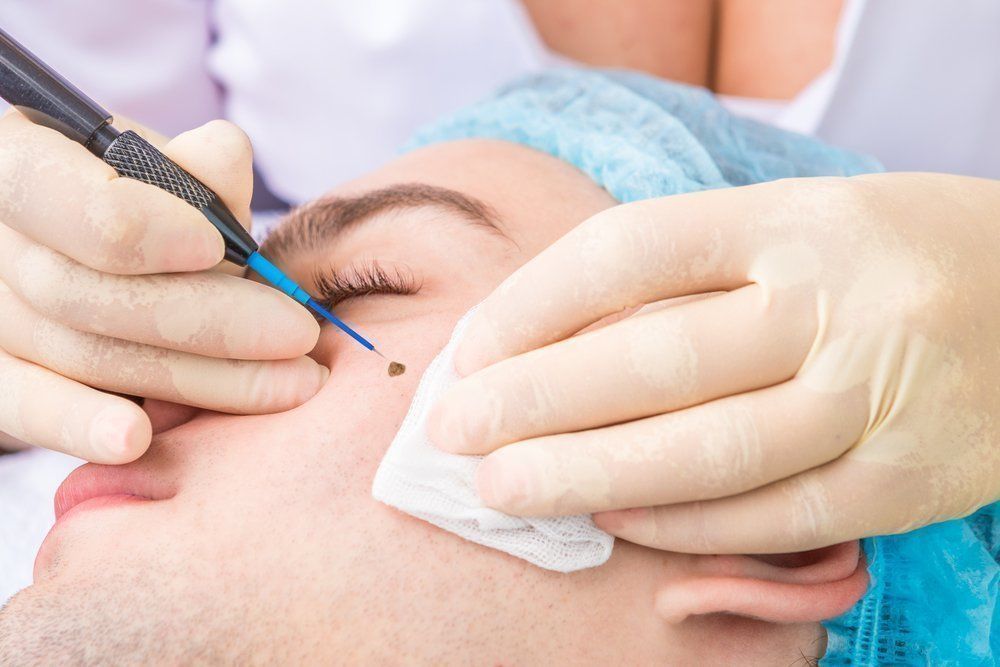While surgical excision remains a common method for mole removal, non-surgical options are gaining popularity in Riyadh due to their less invasive nature, minimal downtime, and reduced scarring. These techniques are particularly suitable for smaller, superficial moles and offer a convenient alternative for those seeking a less invasive approach. It's crucial to remember that a dermatologist should always evaluate any mole before removal to determine the most appropriate course of action and rule out any signs of malignancy. Discover the best options for mole removal in Riyadh with expert dermatologists and advanced treatments for smooth, clear skin.
Common Non-Surgical Mole Removal Techniques:

Several non-surgical techniques are available for mole removal in Riyadh, each with its own advantages and disadvantages:
- Laser Mole Removal: This is perhaps the most popular non-surgical method. Different types of lasers are used depending on the mole's characteristics. Q-switched lasers are effective for removing darker pigments in superficial moles, while CO2 lasers are used for deeper or larger moles by vaporizing the tissue. Laser mole removal offers precision, minimizing damage to surrounding skin and reducing the risk of scarring. It's often a quick procedure with minimal discomfort.
- Cryotherapy (Freezing): Cryotherapy involves freezing the mole with liquid nitrogen. This destroys the targeted tissue. It's a relatively simple and quick procedure, often used for small, superficial moles, skin tags, and warts. Cryotherapy can cause some temporary discomfort or a stinging sensation during the freezing process. A blister may form, which will eventually scab over and fall off.
- Electrocautery (Burning): Electrocautery uses an electric current to burn and destroy the mole tissue. It's a relatively quick procedure, often used for small, raised moles. Electrocautery can cause some discomfort during the procedure, and the treated area may take a few days to heal. There is a small risk of scarring.
- Chemical Peels: Certain chemical peels containing trichloroacetic acid (TCA) can be used to remove some types of superficial moles. The chemical peel causes the top layers of skin to peel away, eventually removing the mole. This method is typically used for multiple small moles or other skin imperfections in the same area. Several treatments may be needed, and there can be some redness and peeling after each treatment.
- Radiofrequency Ablation (RFA): RFA uses radio waves to heat and destroy the mole tissue. It is a minimally invasive technique that can be used for various skin lesions, including some types of moles. RFA offers precision and minimal damage to surrounding tissues.
Advantages of Non-Surgical Mole Removal:
- Less Invasive: Non-surgical methods are less invasive than surgical excision, minimizing trauma to the skin.
- Minimal Downtime: Recovery time is typically shorter than with surgical removal. Most patients can resume their normal activities shortly after the procedure.
- Reduced Scarring: Non-surgical techniques generally result in less noticeable scarring, especially for smaller moles.
- Quick Procedures: The procedures themselves are usually quick, often taking only a few minutes per mole.
- Less Discomfort: While some discomfort may be experienced during the procedure, it is generally minimal and well-tolerated.
Disadvantages of Non-Surgical Mole Removal:
- Not Suitable for All Moles: Non-surgical methods are not appropriate for all types of moles, particularly larger, deeper, or suspicious moles.
- Multiple Treatments May Be Needed: Some techniques, like chemical peels, may require multiple treatments to achieve the desired results.
- Risk of Recurrence: There is a small risk of the mole recurring after non-surgical removal.
- Potential for Pigmentation Changes: Changes in skin pigmentation, such as hyperpigmentation (darkening) or hypopigmentation (lightening), can occur, although this is more common in individuals with darker skin tones.
Choosing the Right Non-Surgical Technique:
The best non-surgical mole removal technique for you will depend on several factors, including:
- Type of Mole: The size, location, and characteristics of the mole.
- Skin Type: Your skin tone and sensitivity.
- Dermatologist's Recommendation: Your dermatologist will assess your mole and recommend the most appropriate treatment.
Finding a Qualified Dermatologist in Riyadh:
Choosing a qualified and experienced dermatologist is crucial for a successful non-surgical mole removal procedure. Look for a dermatologist who:
- Is board-certified and has specialized training in non-surgical mole removal techniques.
- Has extensive experience in performing these procedures.
- Uses appropriate technology and follows strict hygiene protocols.
- Has positive patient reviews and testimonials.
Consultation and Aftercare:
A thorough consultation with a dermatologist is essential before any mole removal procedure. They will examine your mole, discuss your medical history, and recommend the best course of action. Proper aftercare is crucial for optimal healing and minimizing complications. Your dermatologist will provide specific instructions, which you should follow carefully.
Conclusion:
Non-surgical mole removal options offer a less invasive and convenient way to address unwanted moles in Riyadh. By understanding the different techniques available, their advantages and disadvantages, and choosing a qualified dermatologist, you can achieve the desired results and improve your skin's appearance. Always consult with a dermatologist to determine if non-surgical mole removal is right for you and to discuss any concerns you may have.




Comments